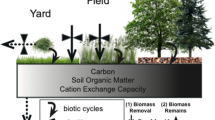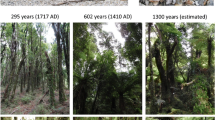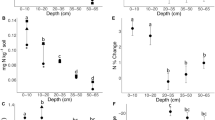Abstract
Background and aims
Models of retrogressive succession have emphasised the role of phosphorus (P) depletion in driving biomass loss on surfaces of increasing geologic age, but the influence of impeded drainage on old surfaces has received much less attention. We tested whether poor drainage contributed to changes in ecosystem properties along a 291,000-year chronosequence in New Zealand (the Waitutu chronosequence).
Methods
Soil and ecosystem properties were measured at 24 evenly distributed points within each of eight 1.5 ha plots located on young, intermediate and old surfaces. Regression analyses tested whether drainage, in addition to P, affected ecosystem functioning. A complementary fertilization experiment tested whether P was indeed limiting on the most nutrient-depleted sites.
Results
Most phosphorus depletion occurred in the early stages of pedogenesis (within 24,000 years), and the older surfaces were similar in soil-P contents, whereas drainage was initially good but became increasingly impeded with surface age. In the fertilizer experiment, species showed positive responses to both nitrogen (N) and P addition on the oldest surfaces, supporting Walker and Syer’s model. However, water table depth was also found to be strongly correlated with plant species composition, forest basal area, light transmission, and litter decomposition when comparisons were made across sites, emphasising that it too has strong influences on ecosystem processes.
Conclusions
Poor drainage influences the process of retrogressive succession along the Waitutu chronosequence. We discuss the implications of our work with regard to other chronosequences, suggesting that topography is likely to have strong influences on retrogressive processes.






Similar content being viewed by others
References
Blakemore LC, Daly BK, Searle PL (1987) Methods for chemical analysis of soils. New Zealand soil bureau scientific report 80. Department of Scientific and Industrial Research, Wellington
Braendle R, Crawford RMM (1999) Plants as amphibians. Perspect Plant Evol Syst 2:56–78
Carswell FE, Richardson SJ, Doherty JE et al (2007) Where do conifers regenerate after selective harvest?: A case study from a New Zealand conifer–angiosperm forest. For Ecol Manag 253:138–147
Chadwick OA, Derry LA, Vitousek PM et al (1999) Changing sources of nutrients during four million years of ecosystem development. Nature 397:491–497
Chapin FS III (1980) The mineral nutrition of wild plants. Annu Rev Ecol Syst 11:233–260
Chapin FS, Walker LR, Fastie CL, Sharman LC (1994) Mechanisms of primary succession following deglaciation at Glacier Bay, Alaska. Ecol Monogr 64:149–175
Coomes DA, Bellingham PJ (2011) Temperate and tropical podocarps: how ecologically alike are they? Smithson Contrib Bot 95:119–140
Coomes DA, Grubb PJ (1996) Amazonian caatinga and related communities at La Esmeralda, Venezuela: forest structure, physiognomy and floristics, and control by soil factors. Vegetatio 122:167–191
Coomes DA, Allen RB, Bentley WA et al (2005) The hare, the tortoise and the crocodile: the ecology of angiosperm dominance, conifer persistence and fern filtering. J Ecol 93:918–935
Coomes DA, Kunstler G, Canham CD, Wright E (2009) A greater range of shade-tolerance niches in nutrient-rich forests: an explanation for positive richness–productivity relationships? J Ecol 97:705–717
Crawford RMM (2000) Ecological hazards of oceanic environments. New Phytol 147:257–281
Crawford RMM, Jeffree CE, Rees WG (2003) Paludification and forest retreat in northern oceanic environments. Ann Bot 91:213–226
Crews TE, Kitayama K, Fownes JH et al (1995) Changes in soil phosphorus fractions and ecosystem dynamics across a long chronosequence in Hawaii. Ecology 76:1407–1424
Gaxiola A, McNeill SM, Coomes DA (2010) What drives retrogressive succession? Plant strategies to tolerate infertile and poorly drained soils. Funct Ecol 24:714–722
Harrington RA, Fownes JH, Vitousek PM (2001) Patterns and components of response to nutrient limitation: comparison of long-term results in N- and P-limited tropical forest ecosystems. Ecosystems 4:646–657
Herbert DA, Fownes JH (1995) Phosphorus limitation of forest leaf area and net primary production on a highly weathered soil. Biogeochemistry 29:223–235
Hewitt AE (1998) New Zealand soil classification. Manaaki Whenua Press, Christchurch
Hobbie SE, Vitousek PM (2000) Nutrient limitation of decomposition in Hawaiian forests. Ecology 81:1867–1877
Hurst JM, Allen RB (2007) A permanent plot method for monitoring indigenous forests: field protocols. Landcare Research, Lincoln
Johnson AH, Frizano J, Vann DR (2003) Biogeochemical implications of labile phosphorus in forest soils determined by the Hedley fractionation procedure. Oecologia 135:487–499
Kitayama K (2005) Comment on “ecosystem properties and forest decline in contrasting long-term chronosequences. Science 308:633–633
Kitayama K, Schuur EAG, Drake DR, Mueller-Dombois D (1997) Fate of a wet montane forest during soil ageing in Hawaii. J Ecol 85:669–679
Lohse KA, Dietrich WE (2005) Contrasting effects of soil development on hydrological properties & flow paths. Water Resour Res 41:W12419. doi:10.1029/2004WR003403
Mark AF, Grealish G, Ward CM, Wilson JB (1988) Ecological studies of a marine terrace sequence in the Waitutu Ecological District of southern New Zealand. Part 1: the vegetation and soil patterns. J R Soc N Z 18:29–58
Noble MG, Lawrence DB, Streveler GP (1984) Sphagnum invasion beneath an evergreen forest canopy in southeastern Alaska. Bryologist 87:119–127
Norton DA (1989) Floristics and structure of mire-forest ecotones, west coast South Island, New Zealand. J R Soc N Z 19:31–42
Økland RH (1990) Vegetation ecology: theory, methods and applications with reference to Fennoscandia. Sommerfeltia Suppl 1:1–233
Parfitt RL, Ross DJ, Coomes DA et al (2005) N and P in New Zealand soil chronosequences and relationships with foliar N and P. Biogeochemistry 75:305–328
Peltzer DA, Wardle DA, Allison VJ et al (2010) Understanding ecosystem retrogression. Ecol Monogr 80:509–529
Phipps RL (1985) Collecting, preparing, crossdating, and measuring tree increment cores. U.S. Dept. of the Interior, Geological Survey, Reston
Pryor RJ, Davidson NJ, Close DC (2006) Waterlogging duration: interspecific comparison of Leptospermum scoparium (Forst et Forst.f.), Acacia melanoxylon (R. Br.), Nothofagus cunninghamii (Hook.) and Eucalyptus obliqua (L’Herit). Austral Ecol 31:408–416
R Core Team (2012) R: a language and environment for statistical computing. R Foundation for Statistical Computing, Vienna
Richardson S, Peltzer D, Allen R et al (2004) Rapid development of phosphorus limitation in temperate rainforest along the Franz Josef soil chronosequence. Oecologia 139:267–276
Richardson SJ, Peltzer DA, Allen RB, McGlone MS (2005) Resorption proficiency along a chronosequence: responses among communities and within species. Ecology 86:20–25
Sauer D, Sponagel H, Sommer M et al (2007) Podzol: soil of the year 2007. A review on its genesis, occurrence, and functions. J Plant Nutr Soil Sci 170:581–597
Schuur EAG (2001) The effect of water on decomposition dynamics in mesic to wet Hawaiian montane forests. Ecosystems 4:259–273
Schuur EAG, Matson PA (2001) Net primary productivity and nutrient cycling across a mesic to wet precipitation gradient in Hawaiian montane forest. Oecologia 128:431–442
Scott NA, Parfitt RL, Ross DJ, Salt GJ (1998) Carbon and nitrogen transformations in New Zealand plantation forest soils from sites with different N status. Can J For Res 28:967–976
Smith SM, Lee WG (1984) Vegetation and soil development on a Holocene river terrace sequence, Arawata Valley, South Westland, New Zealand. N Z J Sci 27:187–196
Soethe N, Lehmann AJ, Engels EC (2006) The vertical pattern of rooting and nutrient uptake at different altitudes of a south Ecuadorian montane forest. Plant Soil 286:287–299
Sun OJ, Sweet GB, Whitehead D, Buchan GD (1995) Physiological responses to water stress and waterlogging in Nothofagus species. Tree Physiol 15:629–638
ter Braak CJF (1986) Canonical correspondence analysis: a new eigenvector technique for multivariate direct gradient analysis. Ecology 67:1167–1179
ter Braak CJF, Prentice IC (1988) A theory of gradient analysis. Adv Ecol Res 18:271–317
Turner BL, Condron LM, Wells A, Andersen KM (2012) Soil nutrient dynamics during podzol development under lowland temperate rain forest in New Zealand. Catena 97:50–62
Ugolini FC, Mann DH (1979) Biopedological origin of peatlands in South East Alaska. Nature 281:366–368
van Breemen N (1995) How Sphagnum bogs down other plants. Trends Ecol Evol 10:270–275
Vitousek PM, Farrington H (1997) Nutrient limitation and soil development: experimental test of a biogeochemical theory. Biogeochemistry 37:63–75
Vitousek PM, Porder S, Houlton BZ, Chadwick OA (2010) Terrestrial phosphorus limitation: mechanisms, implications, and nitrogen–phosphorus interactions. Ecol Appl 20:5–15
Walker TW, Syers JK (1976) The fate of phosphorus during pedogenesis. Geoderma 15:1–19
Walker LR, Wardle DA, Bardgett RD, Clarkson BD (2010) The use of chronosequences in studies of ecological succession and soil development. J Ecol 98:725–736
Ward CM (1988) Marine terraces of the Waitutu district and their relation to the late Cenozoic tectonics of the southern Fiordland region, New Zealand. J R Soc N Z 18:1–28
Wardle P (1991) Vegetation of New Zealand. Cambridge University Press, Cambridge
Wardle DA, Walker LR, Bardgett RD (2004) Ecosystem properties and forest decline in contrasting long-term chronosequences. Science 305:509–513
Zach LW (1950) A northern climax, forest or muskeg? Ecology 31:304–306
Acknowledgments
This is a Waitutu Ecosystem Project paper. Data were collected on Department of Conservation and Maori-owned land currently managed by the Department of Conservation; we thank both groups for their substantial help. We thank Robert Allen, Richard Duncan, Duane Peltzer, Peter Grubb, Peter Bellingham, Sarah Richardson and two anonymous reviewers for advice and comments. We thank the many summer workers and Landcare Research staff who contributed towards data collection and entry, with particular thanks to Sean Husheer for leading on permanent plot measurements. This research was supported by the Foundation for Research, Science and Technology (New Zealand), the Natural Environmental Research Council (UK), the New Zealand Department of Conservation and by investment of retained earnings by Landcare Research.
Author information
Authors and Affiliations
Corresponding author
Additional information
Responsible Editor: Benjamin L. Turner.
Electronic supplementary material
Below is the link to the electronic supplementary material.
ESM 1
(DOCX 49 kb)
Rights and permissions
About this article
Cite this article
Coomes, D.A., Bentley, W.A., Tanentzap, A.J. et al. Soil drainage and phosphorus depletion contribute to retrogressive succession along a New Zealand chronosequence. Plant Soil 367, 77–91 (2013). https://doi.org/10.1007/s11104-013-1649-5
Received:
Accepted:
Published:
Issue Date:
DOI: https://doi.org/10.1007/s11104-013-1649-5




